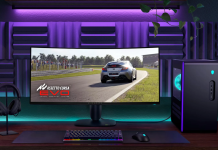
This is the one tablet I’ve had my eyes on since it was announced by Samsung a few months back, it was then half killed-off by Samsung in favour of their thinner Galaxy Tab 10.1. I say half killed-off as the Galaxy Tab 10.1v was picked up by Vodafone in a number of countries including Voda Australia. Lucas, Geoff and myself all purchased the tablet for $729 so don’t think this review is going to have any bias towards either Samsung or Vodafone, not that we take part in that crap anyway. Hit the break for the full review.
Pros..
- Extremely lightweight
- 8MP camera that shoots 1080p video
- Brilliant screen with excellent viewing angles
- Quadband 3G for use on every Aussie network and HSPA+
Cons..
- The LCD panel bleeds light from the edges
- Stereo speakers lack bass
- Google Apps force close at random points in time
- Honeycomb still needs work done
Hardware..
So what we’re dealing with here is the older and thicker version of Samsung’s Galaxy Tab 10.1. In reality there isn’t much of a difference between the two; each has their own pros and cons. The 10.1v measures in at 10.9mm thick which is 2.3mm thicker than the 10.1 and 2mm thinner than the Motorola XOOM. It is also 130 grams lighter than the Motorola Xoom and 5 grams heavier than the 10.1. It weighs in at 600grams and is really, really light in hand, which is quite a welcome surprise after using the heavy Motorola XOOM for 2 weeks before getting the Galaxy Tab 10.1v. The Galaxy Tab 10.1v is powered by Tegra 2 clocked at 1GHz on each core, killing any lag that would ever occur.

Display..
The 10.1v has a 10.1″ (didn’t already guess it?) display with a resolution of 1280×800. 80 of those 800 vertical pixels are used for the system bar that sits permanently at the bottom of the screen, leaving the 1280×720 (HD) resolution for displaying content when in horizontal orientation. When using the display at a normal distance it’s almost impossible to make out any obvious pixels, which is perfect for reading and watching content. The screen is also really responsive and is capable of 10 simultaneous finger presses. Impressive.
There is however a problem with a majority of Galaxy Tab 10.1v’s where the LCD panel is actually bleeding light from parts of the screen. The bleeding isn’t at all obvious in normal use during the day and most of the time at night. However when it is dark and you show a dark image or video, the bleeding can be seen pretty clearly. You can read more about this issue in the post we wrote earlier.
Build..
It’s clear Samsung have done everything they could to keep the 10.1v light but maintain structural integrity. The back and silver bezel around the sides of the device are all plastic, with the rear having a slight bend when you push on it, making it easy to see why Samsung were able to make the 10.1 thinner. The front panel however is covered entirely by what could possibly be Gorilla Glass, meaning it’s extremely hard to scratch. There are stereo speakers on the left and right sides of the device, with the power button and 3.5mm headphone jack situated on the left hand side. The top is where you’ll find the volume rocker and microphone. On the right hand side is where you insert your SIM card and on the bottom you have Samsung’s 30-pin connector which has a multitude of uses, if you have the expensive adapters. For people wondering, it is the exact same connector as that of the original Galaxy Tab.
Overall the Galaxy Tab 10.1v feels really light, maybe even a bit cheap when you first pick it up. But once powered on, it feels like an awesome piece of kit.
Camera..
The main reason I purchased the Galaxy Tab 10.1v over the 10.1 is that it has a massive 8MP camera instead of a 3.15MP camera, and it’s capable of shooting pretty legible 1080p (Full HD) video at 24fps. There is also a single LED which comes in handy for those darker shots. In reality there aren’t a lot of times when you’re going to need to shoot a 1080p video on your Tablet or even use it as a camera if you have a point-and-shoot or a good smartphone on you, though it’s always a nice extra to have. We’ve included some video and photos taken on the 10.1v below for your perusal.
[nggallery id=77]
There front-facing camera is 2MP which is more than you’ll ever need. The video taken with this camera is very fluid and doesn’t appear to be very compressed and looks nice on YouTube at 480p. The microphone also picks up sounds quite clearly. When using the front-facing camera for Gtalk Video Calls, it looks really good and is really smooth.
Battery..
When you have a massive 6860mAh battery, the usage times are going to be pretty good, and they are. With Wi-Fi on, listening to music periodically and everything syncing (4 Gmail accounts, Facebook, Twitter), I easily pulled 3 days of usage, which is absolutely insane. Both Lucas and I went to Sydney for 2 days and not once charged the battery of our Galaxy Tabs, even after some pretty intense use. This is certainly going to be the benchmark for tablet batteries.
Connectivity..
With a quadband radio tuning in to bands 850/900/1900/2100MHz UMTS, it’s got you covered for use on every single network in Australia. This means you can buy it from Vodafone (like I did) and use it on Telstra’s NextG network (like I did, also). It’s also a proper HSPA+ device, meaning it can download at a theoretical speeds of up to 21Mbit and upload at 5.76. In reality I got a top download speed of 12Mbit and upload of 2Mbit whilst in the CBD of Sydney on Telstra’s network.

Software..
Software is the area where the Galaxy Tab 10.1v had most of its issues. Honeycomb in its current form (3.0.1) is buggy, it’s not major but there are some problems with the Google Apps and Market. I’ve had the Gmail app force close on me countless times without warning and the Market will sometimes not even download the app you want. Lucas has had far fewer force closes on his Gmail app and he says that his Market works quite well, so it’s certainly not a widespread issue.
There are currently very few apps made for Honeycomb, I mean there is lucky to be 20 or 30 good Honeycomb apps available on the market. Hopefully the Android 3.1 update will push developers a little more to make apps for this great platform. The apps that are made for Honeycomb (Plume for example) look absolutely amazing and make great use of the extra screen real estate. There are some aps that will crash when you try to launch them as well, or will crash when you try to go to a certain part of the app like we found with the Facebook application.
I know a lot of people have complained about the placing of buttons on the home screens such as the app drawer button being in the top right and the back and home buttons being on the bottom left, when in reality this isn’t a problem at all. Once you’ve become accustomed to the positioning of all the buttons, you don’t even notice the distances apart.
Overall Honeycomb is a massive leap in the right direction for Android on tablets, it just wasn’t fully executed before being put onto the actual devices. With the introduction of Android 3.1, I don’t see why Google can’t fix the small amount problems we had with the software. The only other thing it needs is apps.
Benchmarking..
| Quadrant (Higher = better) | |
|---|---|
| Galaxy Tab 10.1v | 1983 |
| Motorola XOOM | 1823 |

Conclusion
Having used the 10.1v for a good period of time now, I’m having no regrets about my purchase. I feel it’s mainly aimed at early adopters given that it was a limited edition variant on the 10.1 and with quad-core tablets hitting the market by the end of the year, this beast is going to be kicked down the ranks in six months. If that isn’t a problem for you and you just want a tablet that works well, then I would choose this over the XOOM. It’s lighter and it feels much better in the hand and crashes a bit less. Having said that, it’s not the hardware holding these devices back, it’s Honeycomb. Google are hoping to address the current issues with the release of Android 3.1 and for the sake of the early adopters like Lucas, Geoff and myself, I hope it fixes the bugs.
The XOOM and Galaxy Tab 10.1v are the start of the real Honeycomb tablets, so it’s mainly early adopter stuff for now.




